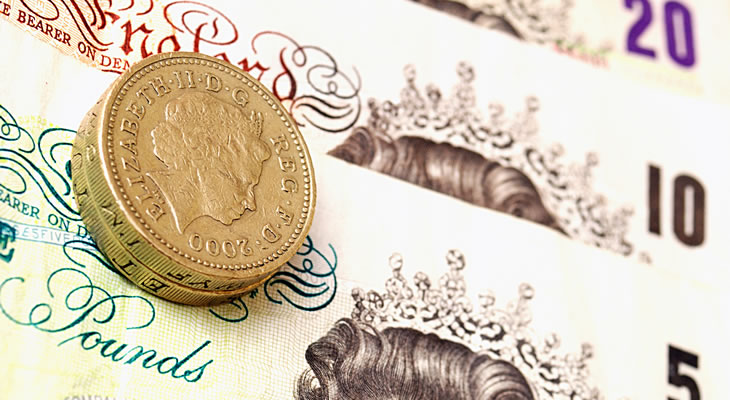- GBP exchange rates mixed despite weak services growth
- AUD conversion rates advance on reduced trade deficit
- NZD exchange rate gains on improved market sentiment
- RBA minutes forecast to provoke significant AUD volatility
Pound Sterling (GBP) Exchange Rates Retreat following Three-Year Low Services Growth
Although the British unit avoided a larger depreciation after speculation of weak services growth was already priced-in, the GBP/AUD and GBP/NZD exchange rates declined as rising crude prices supported demand for high-yielding assets.
Over the past few days the British Pound softened versus its major peers in response to a succession of below-forecast sectoral data. Manufacturing unexpectedly contracted on the month, construction growth came in slower-than-anticipated and the services sector saw growth hit a fresh three-year low.
As a result of the disappointing PMI reports, with particular reference to the services index, second-quarter British economic growth is near-stagnation. Economists at Markit have attributed the slowdown in the UK’s sectoral growth to uncertainty surrounding the EU referendum and fears that a ‘Brexit’ will negatively impact the British economy.
Reporting on the latest disappointing services data, David Noble, Group Chief Executive Officer at the Chartered Institute of Procurement & Supply said;
‘The UK’s services sector is stuck between a rock and a hard place. Mounting global economic uncertainty at the top of the supply chain and the reality of the new National Living Wage at the bottom mean that firms are feeling the pinch from both ends. As a result, the sector credited with being the main driver of the UK’s economic fortunes appears to be slowing down. The looming EU referendum has had a profound effect on the sector, keeping prices relatively stagnant and delaying new orders. At the other end of the supply chain, the National Living Wage has compounded cost increases, resulting in the overall rate of input price inflation hitting a 27-month high. Together, these factors have squeezed margins while fewer than half of businesses expect to grow over the next twelve months.’
Australian Dollar (AUD) Exchange Rate: RBA Minutes to Provoke Volatility
During Thursday’s European session the Australian Dollar climbed versus several of its currency peers despite weaker-than-expected data from China. The appreciation was partly the result of positive domestic trade data, but also in response to improved market sentiment as oil prices rose.
March’s Australian Trade Balance saw the deficit reduced beyond expectations to -2163 million. The improvement to the deficit can be attributed to a massive 4% increase in Australia’s exports, with imports only growing by 1%.
Westpac have attributed the boost to exports to demand for gold, stating;
‘As expected metal ores (mostly iron ore) rose but the 7.6 per cent gain was a bit less than we thought given the [21 per cent] bounce in the Chinese spot price for iron ore,’ Westpac senior economist Matthew Hassan said. ‘The big surprise this month was the almost 60 per cent rise in gold exports. Gold exports are very volatile month to month, they fell 20 per cent in February, and a large correction next month is a genuine possibility.’
Also supportive of demand for the ‘Aussie’ (AUD) was retail sales data which showed 0.4% growth on the month in March.
Later today, the Australian Dollar is likely to see volatility in response to the Performance of Construction Index and the Reserve Bank of Australia (RBA) Statement on Monetary Policy. Given that policymakers unexpectedly cut the overnight cash rate to a record-low 1.75%, the meeting minutes will likely be closely scrutinised by traders.
New Zealand Dollar (NZD) Exchange Rate Advanced on Improved Risk Appetite
Despite a complete absence of domestic data to provoke volatility, the New Zealand Dollar rose versus several of its currency peers during Thursday’s European session. The appreciation came even against the backdrop of weaker-than-expected Chinese services growth and falling dairy prices.
The uptrend, therefore, can be attributed to improved demand for risk-correlated assets. With commodities prices improving in response to rising crude oil prices, high-yield demand was supportive of ‘Kiwi’ (NZD) exchange rates.
With a complete absence of domestic data to provoke changes, the New Zealand Dollar is likely to see changes in response to market sentiment and US Dollar movement. US Unemployment Rate and Change in Non-Farm Payrolls reports will likely have a significant impact on both the New Zealand Dollar and Australian Dollar.
The Pound Sterling to Australian Dollar (GBP/AUD) exchange rate was trending within the range of 1.9307 to 1.9447 during Thursday’s European session.
The Pound Sterling to New Zealand Dollar (GBP/NZD) exchange rate was trending within the range of 2.0945 to 2.1103.


Comments are closed.